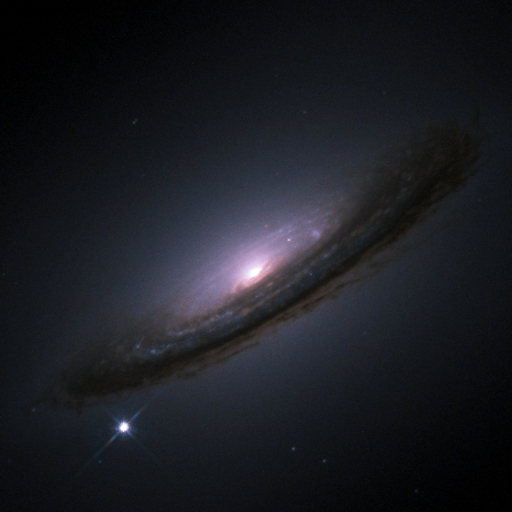- cross-posted to:
- hackernews@lemmy.bestiver.se
- cross-posted to:
- hackernews@lemmy.bestiver.se
If this gets confirmed, it will be a big deal. The fact that anything in cosmology is changing fast enough to be detected as different in a matter of decades is very strange and would mean we’re wrong about a lot of really significant things.
we’re wrong about a lot of really significant things
I think this is probably the safest conclusion we can make about the universe
I mean, I absolutely love that we are trying, but we are apes with lenses
The fact that anything in cosmology is changing fast enough to be detected as different in a matter of decades is very strange and would mean we’re wrong about a lot of really significant things.
Totally. I wonder how much it is methods to measure being refined and new methods being discovered that show such different results.
Ah, it looks like a correction rather than an actual physical change in the value:
However, a team of astronomers at Yonsei University have now put forward new evidence that type Ia supernovae, long regarded as the universe’s “standard candles”, are in fact strongly affected by the age of their progenitor stars.
Even after luminosity standardisation, supernovae from younger stellar populations appear systematically fainter, while those from older populations appear brighter.
Based on a much larger host-galaxy sample of 300 galaxies, the new study confirmed this effect at extremely high significance (99.999% confidence), suggesting that the dimming of distant supernovae arises not only from cosmological effects but also from stellar astrophysics effects.
When this systematic bias was corrected, the supernova data no longer matched the standard ΛCDM cosmological model with a cosmological constant, researchers said.
Instead, it aligned far better with a new model favoured by the Dark Energy Spectroscopic Instrument (DESI) project, derived from baryonic acoustic oscillations (BAO) – effectively the sound of the Big Bang – and cosmic microwave background (CMB) data.
That’s somewhat less astonishing, but still a very big deal. I’ve always had an intuitive soft spot for Big Bounce cosmology–it’s just so neat and would wrap up so many things–and it would be cool if the evidence started supporting that.
The correcting of “standard candles” is a huge deal, but only to astronomy nerds. I never particularly liked the accelerated expansion of the universe and the required exotic explanations for it, but until now I was like :cant-prove-it:
It figures. Still, as the tools get sharper, the questions get weirder, I feel. when the data is getting more incontrovertible, the more responsibility we have to come up with valid explanations.
For me the big question is “what about black holes” in a Big Bounce scenario.
If the Big Bounce happens faster than 10^100 years then there will still be black holes, and things falling into a black hole (such as the entire cosmos) would extend its lifespan.
Also, if the universe does eventually Bounce, new black holes will have opportunity to form. Hawking radiation only really starts to come into play when not even photons are hitting black holes any more.
Hell yeah cyclic universe is back on the table
God I fucking love space.
Recession indicator?
Vaxxed?
another one for the mounting pile of evidence that the 2012 people were right
Terence McKenna stays winning

if any of his or penrose’s ideas about human consciousness primarily arising from a quantum mechanical computational substrate (rather than emerging from the electrophysiology/chemistry, a hypothesis that seems to dominate most of mainstream neuroscience’s hunches on the matter) I’m going to be so salty (I will feel compelled to apologize to a pro-woo family member who insists that they ``understand qm conceptually’')
I’ve never heard a satisfactory answer to the decoherence time scale mismatch problem from the Penrose people. Until they have a really plausible solution to that issue, I have a really hard time considering it a live option.
Imagine the distant future where the galaxies are “rushing” towards each other and we finally have the ability to meet intergalactic aliens. We all join together and collectively freak out over the coming big crunch.
not me tho im going to sell my crunchfront property high, buy the best warp drives, and fly away, while everyone else just sits around and does nothing.
No fucking way
We need to feed it some chilli

Coming right up
Finally some good news
When they say “universe” do they just mean the objects (galaxies) in the emptiness of space are getting further apart or do they mean that the “universe” has a physical property that is actually getting larger?
Additionally, if it is slowing then does that not mean that a force is acting upon it to cause that change? Either a force like friction or extremely long range gravitational forces are acting to slow the rate at which everything gets further apart?
If the latter and there is no limit to the distance that force applies, then on a long enough timeline there is an inevitable reversal. If however it is the former, the only thing that can be assumed is that eventually they will stop moving further away and settle to a distance that does not change further.
My understanding of cosmic expansion is that large masses sort of pin space down to fixed spacial dimensions. Outside of galaxies and such, space gets bigger over time. In the sense that if you tried to cross a cosmic void at speed lower than the expansion rate, you would never cross the space. There are cases where objects are receeding faster than the speed of light, which is impossible unless space is getting bigger. The exact rate of expansion may have been exaggerated by flaws in the distance ladder we use to measure space, which this paper is trying to improve.
The first one
Not necessarily. We don’t really understand gravitational forces the way we understand the other four fundamental interactions.
There is no limit to the distance that gravity has an effect, but gravitational attraction propagates at the speed of light and at large enough distances, the rate of expansion is greater than the speed of light.
Galaxies tend to have random velocity, but the underlying space itself is expanding, which makes everything in space start to move away from everything else. Further away objects have more space between them and us and so appear to move faster. The classic analogy is to mark two dots on an uninflated balloon and then inflate it. The points didn’t move across the balloon’s surface, but they’re now farther apart because the balloon itself is bigger.
How do you tell the difference if all you can do is look at 1a supernovae redshift? Also, if velocity is dx/dt and the distance is changing, what is the difference?
How do you tell the difference if all you can do is look at 1a supernovae redshift?
If it was just standard motion, we’d expect to see a more-or-less random distribution of rates as we looked around: some things should be getting closer, some things should be moving away slowly, and some things should be just hanging out. That’s not what we see. Instead, no matter where we look, it appears that everything is receding from us at a rate that is proportional to distance–the further away something is, the faster it is receding. Since we assume that we aren’t in a privileged position in the universe (that is, we assume we’re not at the center of the universe), the best available explanation is that the actual distances are expanding. The further away something is, the more space there is between us and it, and so the faster it appears to recede. Since we’re not in a special position, that means every other observer anywhere in the universe should see the same thing.
Clever. That makes a lot of sense, thank you.
If I’m sitting still and you’re sitting still and then an earthquake splits the earth and moves us further apart, you could say that you didn’t budge but I moved twice as fast away from you, because reference frames are weird like that.
The redshift is tied to velocity but distance can be measured with the “standard candle method” where a “standard candle” is a star/body that we know the size and distance of. I don’t remember/understand the specifics of how a standard candle comes be (telescopes I guess?) IIRC they use a bit of trigonometry along with the flicker rate/brightness to find the distance of bodies.
So they have a way to measure the distance completely independently of how they measure velocity (redshift/blueshift). Those values didn’t match up but the distance between bodies was observed to be constantly increasing across the board which is why they came to the expansion conclusion.
but the underlying space itself is expanding
What does this mean, what measurement is “space” ? What is space made of?
I have a feeling that you’re about to go on the long and fun journey of trying to get a handle on this stuff. Once you think you have an understanding of Einsteinian physics then you start asking questions about quantum physics and realize how God damned different that is. It’s a good time.
We don’t know if space is a material made of anything, but we treat space as a 4-dimensional coordinate set in our math. We know space is expanding because when we look at things far away, 100% of them are moving away from us, and the farther away they are, the faster they’re moving. Some clever people did the math and established that the only reasonable cause for that is space itself expanding, so things that are further away move away faster because there’s more space between us to expand.
We also don’t know (and very possibly can’t know) if there are discrete units of what we consider “space” to be or if it is a continuum
As I understand it, it is based on the velocities of galaxies/stars (redshift/blueshift) along with their relative locations. IIRC the velocities of the bodies don’t square with the constantly increasing distance between the bodies which is why they came to the conclusion that the universe was expanding.
It’s been over 10 years since I took that one astronomy class in college but I think the math and logic made good enough sense. However, I always reserve a small amount of skepticism for astronomy because 90% of it (as I understand it) is based on bits of light we can see from out here. The universe is so vast how can we be so sure the light shift is only due to movement, or that flicker frequency is only tied to distance.
The scientific history of humans is filled to the brim with shit we were confidently wrong about for centuries.
Either way, the expansion of the universe is not something that has a practical effect on our lives for maybe a few hundred generations, if that.
There’s some wild stuff going on in astronomy. This particular hypothesis was made using baryonic acoustic oscillation (BAO) data. The idea is that the early universe was hot and dense, and random fluctuations would make certain areas more or less dense, like ripples in a pond. Then when the universe rapidly expanded, all those oscillations and over/under densities were frozen as they were, and we can look at the cosmic microwave background and the structure of the modern universe to see how those original changes in density evolved into modern galaxies and voids. This gives us a measuring stick for distance that’s completely independent of using the light of distant events. And BAO and standard candles like 1a supernovas basically agree with each other completely on the expansion rate, and only with higher precision modern instruments have we detected that the methods disagree on the rate of expansion. This paper is trying to square that circle by critically analyzing the validity of the data we measure.
They mean both I believe since the physical properties of the universe are what would presumably drive its expansion, and this expansion results in the cosmological objects in the universe getting farther apart. Actually more than that, it was previously thought that they are accelerating apart, so they would be moving apart at ever increasing speed. However this new data is being presented as evidence that the expansion of the universe is actually slowing down. Still moving apart but at an ever slower rate.


















